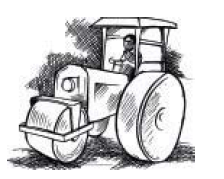Chapter 11- Mensuration Ex 11.3
Keeping the examination point of view in mind the mathematicsandinformationtechnology.com team has prepared NCERT Solutions for Class 8 Maths Chapter 11 Mensuration Exercise 11.3. The NCERT Solutions for chapter Mensuration solutions explains the easy and simple way to solve the problems. By understanding these ways in NCERT Solutions for Class 8, students will be confident while solving such problems found in Chapter 11 Mensuration Exercise 11.3
Question 1:
There are two cuboidal boxes as shown in the adjoining figure. Which box requires the lesser amount of material to make?
Answer:
We know that,
Total surface area of the cuboid = 2 (lh + bh + lb)
Total surface area of the cube = 6 (l)2
Total surface area of cuboid (a) = [2{(60) (40) + (40) (50) + (50) (60)}] cm2
= [2(2400 + 2000 + 3000)] cm2= (2 × 7400) cm2= 14800 cm2
Total surface area of cube (b) = 6 (50 cm)2 = 15000 cm2
Thus, the cuboidal box (a) will require lesser amount of material.
Question 2:
A suitcase with measures 80 cm × 48 cm × 24 cm is to be covered with a tarpaulin cloth. How many metres of tarpaulin of width 96 cm is required to cover 100 such suitcases?
Answer:
Total surface area of suitcase = 2[(80) (48) + (48) (24) + (24) (80)]
= 2[3840 + 1152 + 1920]
= 13824 cm2
Total surface area of 100 suitcases = (13824 × 100) cm2
= 1382400 cm2
Required tarpaulin = Length × Breadth
1382400 cm2 = Length × 96 cm
Length = 1382400/96
= 14400 cm= 144 m
Thus, 144 m of tarpaulin is required to cover 100 suitcases.
Question 3:
Find the side of a cube whose surface area is 600 cm2.
Answer:
Given that, surface area of cube = 600 cm2
Let the length of each side of cube be l.
Surface area of cube = 6 (Side)2
600 cm2 = 6l2
l2= 100 cm2
l = 10 cm
Thus, the side of the cube is 10 cm.
Question 4:
Rukhsar painted the outside of the cabinet of measure 1 m × 2 m × 1.5 m. How much surface area did she cover if she painted all except the bottom of the cabinet?
Answer:
Length (l) of the cabinet = 2 m
Breadth (b) of the cabinet = 1 m
Height (h) of the cabinet = 1.5 m
Area of the cabinet that was painted = 2h (l + b) + lb
= [2 × 1.5 × (2 + 1) + (2) (1)] m2
= [3(3) + 2] m2
= (9 + 2) m2
= 11 m2
Question 5:
Daniel is painting the walls and ceiling of a cuboidal hall with length, breadth and height of 15 m, 10 m and 7 m respectively. From each can of paint 100 m2 of area is painted. How many cans of paint will she need to paint the room?
Answer:
Given that,
Length (l) = 15 m, breadth (b) = 10 m, height (h) = 7 m
Area of the hall to be painted = Area of the wall + Area of the ceiling
= 2h (l + b) + lb= [2(7) (15 + 10) + 15 ×10] m2= [14(25) + 150] m2= 500 m2
It is given that 100 m2 area can be painted from each can.
Number of cans required to paint an area of 500 m2
=500/5
Hence, 5 cans are required to paint the walls and the ceiling of the cuboidal hall.
Question 6:
Describe how the two figures at the right are alike and how they are different. Which box has larger lateral surface area?
Answer:
Similarity between both the figures is that both have the same heights.
The difference between the two figures is that one is a cylinder and the other is a cube.
Lateral surface area of the cube = 4l2 = 4 (7 cm)2 = 196 cm2
Lateral surface area of the cylinder = 2πrh cm2 = 154 cm2
Hence, the cube has larger lateral surface area.
Question 7:
A closed cylindrical tank of radius 7 m and height 3 m is made from a sheet of metal.How much sheet of metal is required?
Answer:
Total surface area of cylinder = 2πr (r + h)
= 440 m2
Thus, 440 m2 sheet of metal is required.
Question 8:
The lateral surface area of a hollow cylinder is 4224 cm2. It is cut along its height and formed a rectangular sheet of width 33 cm. Find the perimeter of rectangular sheet?
Answer:
A hollow cylinder is cut along its height to form a rectangular sheet.
Area of cylinder = Area of rectangular sheet
4224 cm2 = 33 cm × Length
Thus, the length of the rectangular sheet is 128 cm.
Perimeter of the rectangular sheet = 2 (Length + Width)
= [2 (128 + 33)] cm= (2 × 161) cm= 322 cm
Question 9:
A road roller takes 750 complete revolutions to move once over to level a road. Find the area of the road if the diameter of a road roller is 84 cm and length is 1 m.
Answer:
In one revolution, the roller will cover an area equal to its lateral surface area.
Thus, in 1 revolution, area of the road covered = 2πrh
In 750 revolutions, area of the road covered
=750 × 2.64 cm2= 1980 m2
Question 10:
A company packages its milk powder in cylindrical container whose base has a diameter of 14 cm and height 20 cm. Company places a label around the surface of the container (as shown in the figure). If the label is placed 2 cm from top and bottom, what is the area of the label.
Answer:
Height of the label = 20 cm − 2 cm − 2 cm = 16 cm
Radius of the label
Label is in the form of a cylinder having its radius and height as 7 cm and 16 cm.
Area of the label = 2π (Radius) (Height)
=2 × 22/7 × 7 × 16
=704 cm2













